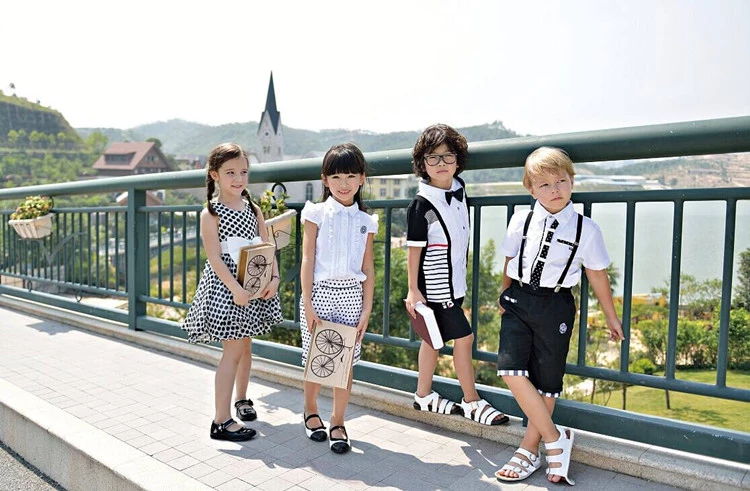The Trend of the Kids Wear Market (Part Two)
The middle-end market is mainly the discounted children's wear store brand, covering a wide range of consumer groups. Children's clothing discount store brand occasionally appear in the second and third tier markets in China, and the demand exceeds supply. Discounted children's wear store brand is in a stage of rapid development.
The middle-end market is highly cost effective, which is the main characteristic of the middle-end market. Customers can obtain store brand with very low price. The terminal market is expanding faster than brand competition and has not yet formed a brand with leadership. Therefore, the emergence of discounted children's wear store brand brings unlimited opportunities to children's clothing. In the next five years, there will be a leading brand company in the brand discount industry in China. Large scales and chain stores are the development trend of discounted children's wear store brand.
The combination of online and offline children's clothing industry is a big advantage. The combination of online and offline of the current marketing mode will certainly replace the simple offline store sales mode. Discounted children's wear store brand industry has many brands, thousands of styles and low prices. Displaying kids wear at online shops makes middle-end consumers see more kids wear products online, truly helping distributors and middle-end consumers have a win-win situation.
The data shows that 96% of millennials use mobile phones to pay for the bill while shopping in stores, and mobile devices such as mobile phones have become shopping companions for millennials. In the future, the combination of online and offline will become a new consumption trend, and omni-channel garment companies and retailers will become real winners.
On the one hand, as many shopping options as possible expand the sales channels of clothing brands. On the other hand, they can also maximize the consumers' shopping experience. The CEO of PEACEBIRD once said: "We firmly hold on to the two richest people Jianlin Wang and Yu Ma in China. First, we are going to open stores at Wanda malls own by Jianlin Wang. Second, we are going to open an online shop." However, combining online and offline shops depends on the channel integration capabilities of garment companies and retailers.
In order to get rid of bad situation of the main clothing business, many clothing companies have started reforms, cooperation with other fields or new business. In the future, this trend will continue to grow. For example, La Chapelle invests greatly in a coffee business, and Lancy buys two major medical brands. SEPTWOLVES not only invests in real estate, but also involves in reinsurance. Once the diversification strategy of the garment industry is well developed, it seems that it is inevitable not to sticking to the original business.
The middle-end market is highly cost effective, which is the main characteristic of the middle-end market. Customers can obtain store brand with very low price. The terminal market is expanding faster than brand competition and has not yet formed a brand with leadership. Therefore, the emergence of discounted children's wear store brand brings unlimited opportunities to children's clothing. In the next five years, there will be a leading brand company in the brand discount industry in China. Large scales and chain stores are the development trend of discounted children's wear store brand.
The combination of online and offline children's clothing industry is a big advantage. The combination of online and offline of the current marketing mode will certainly replace the simple offline store sales mode. Discounted children's wear store brand industry has many brands, thousands of styles and low prices. Displaying kids wear at online shops makes middle-end consumers see more kids wear products online, truly helping distributors and middle-end consumers have a win-win situation.
The data shows that 96% of millennials use mobile phones to pay for the bill while shopping in stores, and mobile devices such as mobile phones have become shopping companions for millennials. In the future, the combination of online and offline will become a new consumption trend, and omni-channel garment companies and retailers will become real winners.
On the one hand, as many shopping options as possible expand the sales channels of clothing brands. On the other hand, they can also maximize the consumers' shopping experience. The CEO of PEACEBIRD once said: "We firmly hold on to the two richest people Jianlin Wang and Yu Ma in China. First, we are going to open stores at Wanda malls own by Jianlin Wang. Second, we are going to open an online shop." However, combining online and offline shops depends on the channel integration capabilities of garment companies and retailers.
In order to get rid of bad situation of the main clothing business, many clothing companies have started reforms, cooperation with other fields or new business. In the future, this trend will continue to grow. For example, La Chapelle invests greatly in a coffee business, and Lancy buys two major medical brands. SEPTWOLVES not only invests in real estate, but also involves in reinsurance. Once the diversification strategy of the garment industry is well developed, it seems that it is inevitable not to sticking to the original business.





